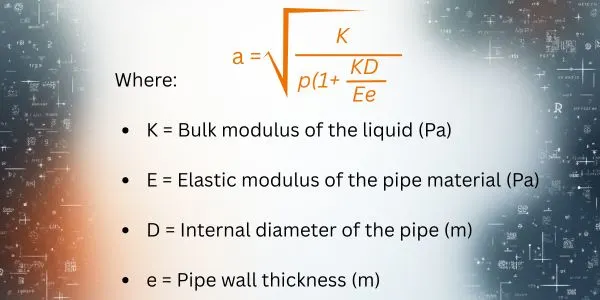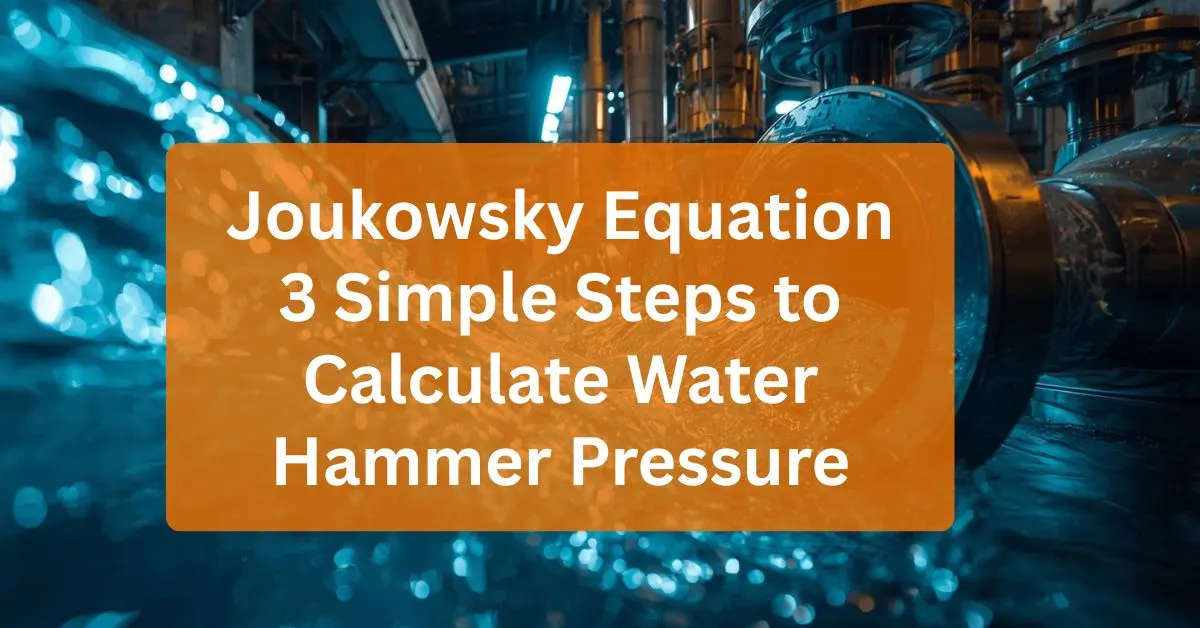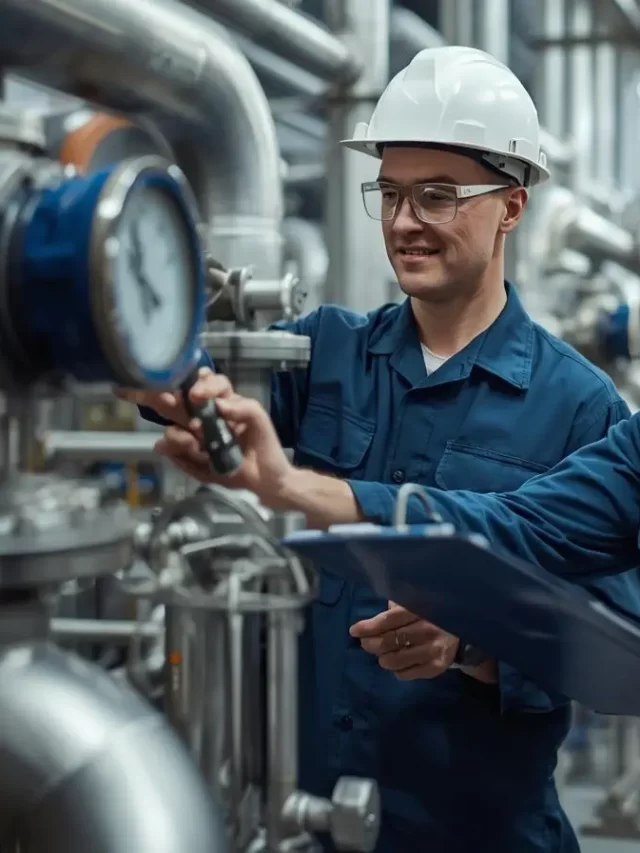Table of Contents
ToggleWater hammer is one of the most common and destructive problems in piping systems. It occurs when a flowing fluid is suddenly forced to stop or change direction such as when a valve closes too quickly.
The sudden deceleration creates a pressure surge or wave that travels through the pipe at high speed.
To understand this phenomenon, engineers use the Joukowsky Equation, which provides a simple yet powerful way to calculate the magnitude of that surge pressure.
What is the Joukowsky Equation?
The Joukowsky equation is a relationship between the change in fluid velocity and the resulting pressure rise caused by that change.

This simple formula is the basis for almost all surge pressure calculations in liquid piping systems.
Let us understand each term
1. Fluid Density (ρ)
The density of the fluid determines how much inertia it has.
For example:
- Water at 25°C → 1000 kg/m³
- Oil → 800–900 kg/m³
- Seawater → 1025 kg/m³
The higher the density, the larger the potential surge pressure.
2. Wave Speed (a)
Wave speed also known as celerity, is the speed at which the pressure wave travels through the pipe.

It depends on both the fluid compressibility and the pipe wall elasticity.
Typical wave speeds:
=> Steel pipe (water): 1000–1300 m/s
=> PVC pipe (water): 300–400 m/s
=> Copper tube: 1200–1400 m/s
If the pipe wall is flexible, the wave speed is lower, and the surge pressure reduces accordingly.
3. Change in Velocity (ΔV)
This is the difference between the initial velocity of the fluid and its velocity after valve closure or flow interruption. If flow drops from 2 m/s to 0 m/s instantly, ΔV = 2 m/s.
Let us take an Example
Let’s take a practical example using new values to keep this calculation original.
Given:
=> Fluid: Water (ρ = 1000 kg/m³)
=> Pipe: Steel pipeline
=> Wave speed, a = 1200 m/s
=> Velocity before closure, V₁ = 2.5 m/s
=> Velocity after closure, V₂ = 0 m/s
So, ΔV = 2.5 m/s
Calculate the pressure rise:
ΔP=ρ×a×ΔV
ΔP=1000×1200×2.5
ΔP=3,000,0000 Pa=3.0 MPa
ΔP=3.0 MPa
So, the sudden valve closure generates a pressure surge of 3.0 MPa (≈ 30 bar).
That is enough to damage pipe joints, valves, or even rupture weaker sections.
Effect of Valve Closing Time
The Joukowsky equation assumes an instantaneous velocity change meaning the valve closes faster than the pressure wave can travel to the next boundary and reflect back.
But in real systems, if the valve closing time (tₑ) is longer than twice the pipe’s travel time (2L/a), the surge is smaller.

If the valve closes slower than 0.67 seconds, the pressure surge will be significantly less than 3 MPa.
Practical Implications in Piping Systems
1) Pipeline Design:
Engineers must ensure that the design pressure rating (PN or ANSI class) can handle occasional surge events.
For example, if the normal pressure is 8 bar, but a transient can create 30 bar, the pipeline must be rated accordingly.
2) Instrumentation Protection:
Pressure transmitters and gauges should not be exposed directly to surge points. Use snubbers, pulsation dampeners, or remote seals to prevent damage.
3) Valve Operation:
Operators should avoid rapid valve closure. Automated control valves often include damping features to slow down travel.
4) Surge Tanks or Air Chambers:
In long pipelines, installing surge vessels, accumulators, or air cushions can absorb the shock wave and protect the system.
5) Pipeline Anchoring:
Support structures and pipe anchors must be strong enough to withstand transient thrust forces caused by water hammer.
Typical Symptoms of Water Hammer
1) Loud banging or knocking noise in the pipeline
2) Sudden pressure spikes shown on gauges
3) Vibration of pipe supports or valves
4) Damaged gaskets, seals, or flanges
5) Transmitter zero shift or failure after surges
Water hammer happens when you stop moving water too suddenly.
The fluid’s momentum turns into a high-pressure wave that rushes through the pipeline, like a hammer blow.
The Joukowsky Equation (ΔP = ρ·a·ΔV) helps engineers estimate how big that pressure spike will be.
By knowing fluid density, wave speed, and velocity change, we can design safer piping systems and prevent failures before they happen.
What we learn today?
Even though the Joukowsky equation is more than 100 years old, it remains one of the most useful and practical tools in hydraulic and instrumentation engineering.
A small calculation using this simple formula can save pipelines, valves, and transmitters from catastrophic damage making it a must know for every instrumentation and process engineer
I hope you like above blog. There is no cost associated in sharing the article in your social media. Thanks for Reading !! Happy Learning









